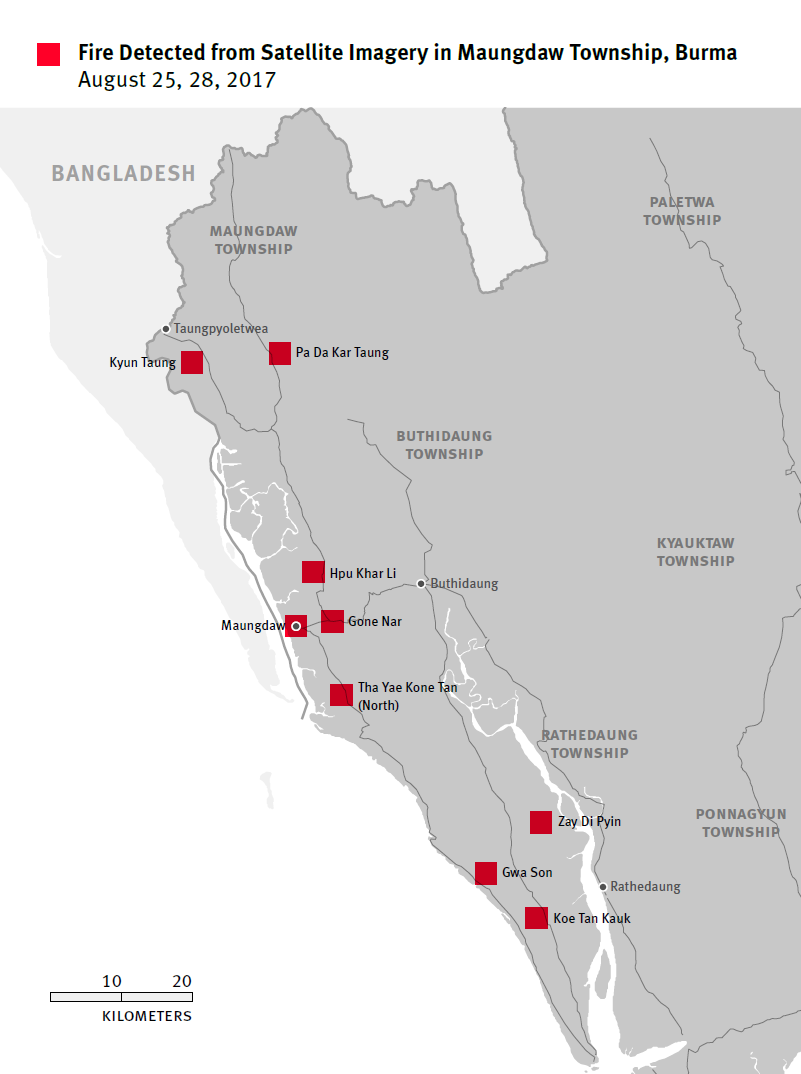Burma: Rohingya Describe Military Atrocities
September 9, 2017

Military’s ‘Unfinished Business’ Has Hallmarks of ‘Ethnic Cleansing’
(New York) – Ethnic Rohingya Muslims fleeing Burmese security forces in Burma’s Rakhine State have described killings, shelling, and arson in their villages that have all the hallmarks of a campaign of “ethnic cleansing,” Human Rights Watch said today.
Burmese army, police, and ethnic Rakhine armed groups have carried out operations against predominantly Rohingya villages since the August 25, 2017 attacks by Arakan Rohingya Salvation Army (ARSA) militants against about 30 police posts and an army base. Burmese army commander Sr. Gen. Min Aung Hlaing told the media that the government-approved military clearance operations in Rakhine State was “unfinished business” dating back to the Second World War.
The United Nations Security Council should hold a public emergency meeting and warn the Burmese authorities that they will face severe sanctions unless they put an end to the brutal campaign against the Rohingya population.
The United Nations and concerned governments need to press Burma right now to end these horrific abuses against the Rohingya as a first step toward restoring Rohingya to their homes.
—Meenakshi Ganguly
“Rohingya refugees have harrowing accounts of fleeing Burmese army attacks and watching their villages be destroyed,” said Meenakshi Ganguly, South Asia director. “Lawful operations against armed groups do not involve burning the local population out of their homes.”
In early September, Human Rights Watch interviewed more than 50 Rohingya refugees who had fled across the border to Bangladesh and obtained detailed accounts from about a dozen people. The Rohingya told Human Rights Watch that Burmese government security forces had carried out armed attacks on villagers, inflicting bullet and shrapnel injuries, and burned down their homes. They described the military’s use of small arms, mortars, and armed helicopters in the attacks.
Human Rights Watch obtained satellite data and images that are consistent with widespread burnings in northern Rakhine State, encompassing the townships of Rathedaung, Buthidaung, and Maungdaw. To date, Human Rights Watch has found 21 unique locations where heat sensing technology on satellites identified significant, large fires. Knowledgeable sources in Bangladesh told Human Rights Watch that they heard the distinctive sounds of heavy and light machine gun fire and mortar shelling in villages just across the border in Burma, and spotted smoke arising from these villages shortly afterward.
Map depicting sites where satellite sensors detected active fires between August 25 and 28, 2017. (Note that the size of the box does not represent the size of the fire detected.)
The Burmese government has denied security force abuses, claiming that it is engaged in a counterterrorism operation in which nearly 400 people have been killed, most of them suspected militants. The Burmese authorities assert, without substantiating their claims, that militants and Rohingya villagers have burned 6,845 houses across 60 villages in northern Rakhine State. Refugee accounts contradict the claims of Burmese officials.
For example, Momena, a 32-year-old Rohingya woman from Maungdaw Township, said that she fled to Bangladesh on August 26, a day after security forces attacked her village. She first hid with her children when the soldiers arrived, but returning to the village she said she saw 40 to 50 villagers dead, including some children and elderly people: “All had knife wounds or bullet wounds, some had both. My father was among the dead; his neck had been cut open. I was unable to do last rites for my father – I just fled.”
At the Cox’s Bazar hospital, Human Right Watch interviewed several Rohingya with bullet wounds. Some said they were hit while at home, others said they were shot when running for safety from their villages, or while hiding in the fields or hills from Burmese soldiers.


